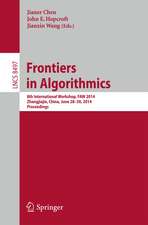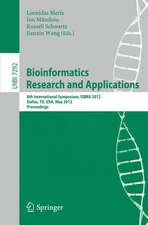Bioinformatics Research and Applications: 10th International Symposium, ISBRA 2014, Zhangjiajie, China, June 28-30, 2014, Proceedings: Lecture Notes in Computer Science, cartea 8492
Editat de Mitra Basu, Yi Pan, Jianxin Wangen Limba Engleză Paperback – 4 aug 2014
Din seria Lecture Notes in Computer Science
- 20%
 Preț: 1061.55 lei
Preț: 1061.55 lei - 20%
 Preț: 307.71 lei
Preț: 307.71 lei - 20%
 Preț: 438.69 lei
Preț: 438.69 lei - 20%
 Preț: 579.30 lei
Preț: 579.30 lei -
 Preț: 410.88 lei
Preț: 410.88 lei - 17%
 Preț: 427.22 lei
Preț: 427.22 lei - 20%
 Preț: 596.46 lei
Preț: 596.46 lei - 15%
 Preț: 448.04 lei
Preț: 448.04 lei - 20%
 Preț: 353.50 lei
Preț: 353.50 lei -
 Preț: 389.49 lei
Preț: 389.49 lei - 20%
 Preț: 309.90 lei
Preț: 309.90 lei - 20%
 Preț: 645.28 lei
Preț: 645.28 lei - 20%
 Preț: 763.23 lei
Preț: 763.23 lei - 15%
 Preț: 580.46 lei
Preț: 580.46 lei - 20%
 Preț: 310.28 lei
Preț: 310.28 lei - 20%
 Preț: 655.02 lei
Preț: 655.02 lei - 20%
 Preț: 1183.14 lei
Preț: 1183.14 lei - 20%
 Preț: 340.32 lei
Preț: 340.32 lei -
 Preț: 449.57 lei
Preț: 449.57 lei - 20%
 Preț: 591.51 lei
Preț: 591.51 lei - 18%
 Preț: 938.83 lei
Preț: 938.83 lei - 20%
 Preț: 337.00 lei
Preț: 337.00 lei - 20%
 Preț: 649.50 lei
Preț: 649.50 lei - 20%
 Preț: 607.40 lei
Preț: 607.40 lei - 20%
 Preț: 1414.79 lei
Preț: 1414.79 lei - 20%
 Preț: 1024.44 lei
Preț: 1024.44 lei - 20%
 Preț: 583.40 lei
Preț: 583.40 lei - 20%
 Preț: 453.32 lei
Preț: 453.32 lei - 20%
 Preț: 575.49 lei
Preț: 575.49 lei - 20%
 Preț: 1075.26 lei
Preț: 1075.26 lei - 20%
 Preț: 585.88 lei
Preț: 585.88 lei - 20%
 Preț: 825.93 lei
Preț: 825.93 lei - 17%
 Preț: 360.20 lei
Preț: 360.20 lei - 20%
 Preț: 763.23 lei
Preț: 763.23 lei - 20%
 Preț: 340.32 lei
Preț: 340.32 lei - 20%
 Preț: 504.58 lei
Preț: 504.58 lei - 20%
 Preț: 369.13 lei
Preț: 369.13 lei - 20%
 Preț: 580.93 lei
Preț: 580.93 lei - 20%
 Preț: 343.62 lei
Preț: 343.62 lei - 20%
 Preț: 350.21 lei
Preț: 350.21 lei - 20%
 Preț: 583.40 lei
Preț: 583.40 lei - 20%
 Preț: 583.40 lei
Preț: 583.40 lei - 15%
 Preț: 438.59 lei
Preț: 438.59 lei - 20%
 Preț: 341.95 lei
Preț: 341.95 lei - 20%
 Preț: 238.01 lei
Preț: 238.01 lei - 20%
 Preț: 538.30 lei
Preț: 538.30 lei
Preț: 395.63 lei
Nou
Puncte Express: 593
Preț estimativ în valută:
75.71€ • 82.21$ • 63.60£
75.71€ • 82.21$ • 63.60£
Carte tipărită la comandă
Livrare economică 22 aprilie-06 mai
Preluare comenzi: 021 569.72.76
Specificații
ISBN-13: 9783319081700
ISBN-10: 3319081705
Pagini: 428
Ilustrații: XVIII, 409 p. 115 illus.
Dimensiuni: 155 x 235 x 27 mm
Greutate: 0.59 kg
Ediția:2014
Editura: Springer International Publishing
Colecția Springer
Seriile Lecture Notes in Computer Science, Lecture Notes in Bioinformatics
Locul publicării:Cham, Switzerland
ISBN-10: 3319081705
Pagini: 428
Ilustrații: XVIII, 409 p. 115 illus.
Dimensiuni: 155 x 235 x 27 mm
Greutate: 0.59 kg
Ediția:2014
Editura: Springer International Publishing
Colecția Springer
Seriile Lecture Notes in Computer Science, Lecture Notes in Bioinformatics
Locul publicării:Cham, Switzerland
Public țintă
ResearchCuprins
Predicting Disease Risks Using Feature Selection Based on Random Forest and Support Vector Machine.- Phylogenetic Bias in the Likelihood Method Caused by Missing Data Coupled with Among-Site Rate Variation: An Analytical Approach.- An Eigen decomposition Method for Protein Structure Alignment.- Functional Interplay between Hemagglutinin and Neuraminidase of Pandemic 2009 H1N1 from the Perspective of Virus Evolution.- Predicting Protein Submitochondrial Locations Using a K-Nearest Neighbors Method Based on the Bit-Score Weighted Euclidean Distance.- Algorithms Implemented for Cancer Gene Searching and Classifications.- Dysregulated microRNA Profile in HeLa Cell Lines Induced by Lupeol.- A Simulation for Proportional Biological Operational Mu-Circuit.- Computational Prediction of Human Saliva-Secreted Proteins.- A Parallel Scheme for Three-Dimensional Reconstruction in Large-Field Electron Tomography.- An Improved Correlation Method Based on Rotation Invariant Feature for Automatic Particle Selection.- An Effective Algorithm for Peptide de novo Sequencing from Mixture MS/MS Spectra.- Identifying Spurious Interactions in the Protein-Protein Interaction Networks Using Local Similarity Preserving Embedding.- Multiple RNA Interaction with Sub-optimal Solutions.- Application of Consensus String Matching in the Diagnosis of Allelic Heterogeneity (Extended Abstract).- Continuous Time Bayesian Networks for Gene Network Reconstruction: A Comparative Study on Time Course Data.- Drug Target Identification Based on Structural Output Controllability of Complex Networks.- NovoGMET: De Novo Peptide Sequencing Using Graphs with Multiple Edge Types (GMET) for ETD/ECD Spectra.- Duplication Cost Diameters.- Computational Identification of De-Centric Genetic Regulatory Relationships from Functional Genomic Data.- Classification of Mutations by Functional Impact Type: Gain of Function, Loss of Function and Switch of Function.- Network Analysis of Human Disease Comorbidity Patterns Based on Large-Scale Data Mining.- Identification of Essential Proteins by Using Complexes and Interaction Network.- GenoScan: Genomic Scanner for Putative miRNA Precursors.- Searching SNP Combinations Related to Evolutionary Information of Human Populations on HapMap Data.- 2D Pharmacophore Query Generation.- Structure-Based Analysis of Protein Binding Pockets Using Von Neumann Entropy.- A New Mathematical Model for Inbreeding Depression in Large Populations.- dSpliceType: A Multivariate Model for Detecting Various Types of Differential Splicing Events Using RNA-Seq.- Conformational Transitions and Principal Geodesic Analysis on the Positive Semidefinite Matrix Manifold.- Joint Analysis of Functional and Phylogenetic Composition for Human Microbiome Data.- schematikon: Detailed Sequence-Structure Relationships from Mining a Non-redundant Protein Structure Database (Extended Abstract).- PNImodeler: Web Server for Inferring Protein Binding Nucleotides from Sequence Data.- A MCI Decision Support System Based on Ontology.- Context Similarity Based Feature Selection Methods for Protein Interaction Article Classification.- Network Propagation Reveals Novel Genetic Features Predicting Drug Response of Cancer Cell Lines.- Splice Site Prediction Using Support Vector Machine with Markov Model and Codon Information.- Exploiting Topic Modeling to Boost Metagenomic Sequences Binning.- Network-Based Method for Identifying Overlapping Mutated Driver Pathways in Cancer.- Completing a Bacterial Genome with in silico and Wet Lab Approaches.- Protein Function Prediction: A Global Prediction Method with Multiple Data Sources.- A microRNA-Gene Network in Ovarian Cancer from Genome-Wide QTL Analysis.- K-Profiles Nonlinear Clustering.- Estrogen Induced RNA Polymerase II Stalling in Breast Cancer Cell Line MCF7.- A Knowledge-Driven Approach in Constructing a Large-Scale Drug-Side Effect Relationship Knowledge Base for Computational Drug Discovery.- Systems Biology Approach to Understand Seed Composition.- Prediction of the Cooperative cis-regulatory Elements for Broadly Expressed Neuronal Genes in Caenorhabditis Elegans.- Improving the Mapping of the Smith-Waterman Sequence Database Search Algorithm onto CUDA GPUs.- VFP: A Visual Tool for Predicting Gene-Fusion Base on Analyzing Single-end RNA-Sequence.- A Novel Method for Identifying Essential Proteins from Active PPI Networks.- RAUR: Re-alignment of Unmapped Reads with Base Quality Score.- PIGS: Improved Estimates of Identity-by-Descent Probabilities by Probabilistic IBD Graph Sampling.- Clustering PPI Data through Improved Synchronization-Based Hierarchical Clustering Method.- Order Decay in Transcription Regulation in Type 1 Diabetes.- Simulated Regression Algorithm for Transcriptome Quantification.



























